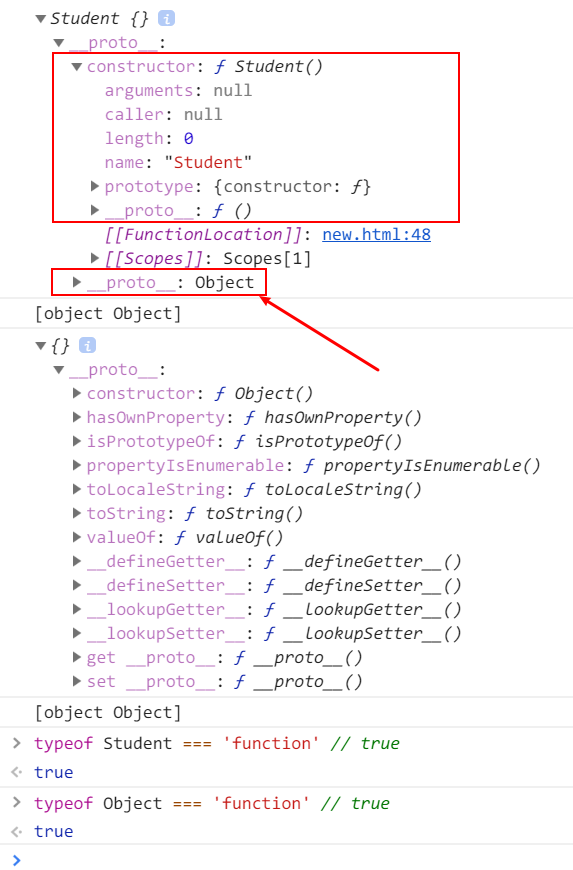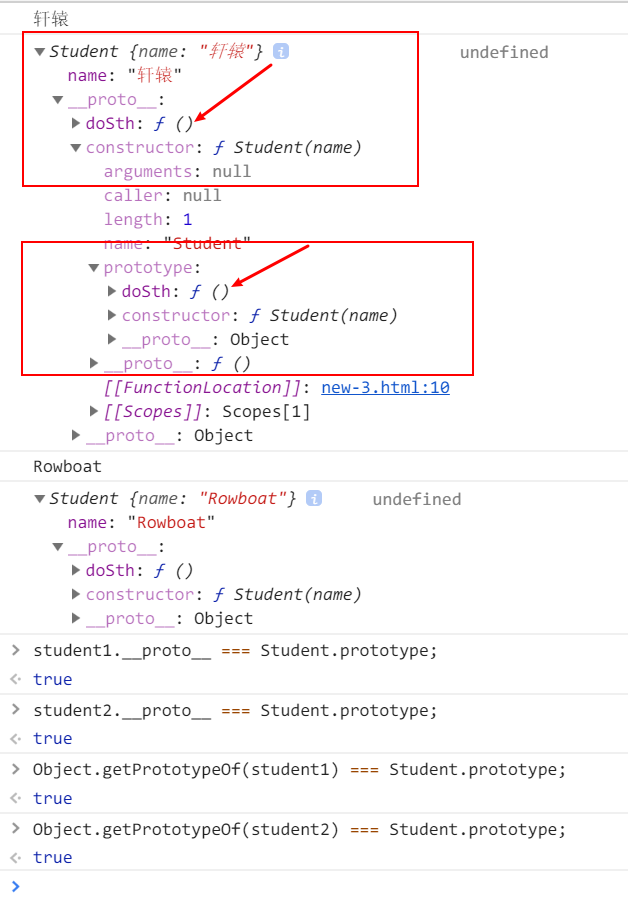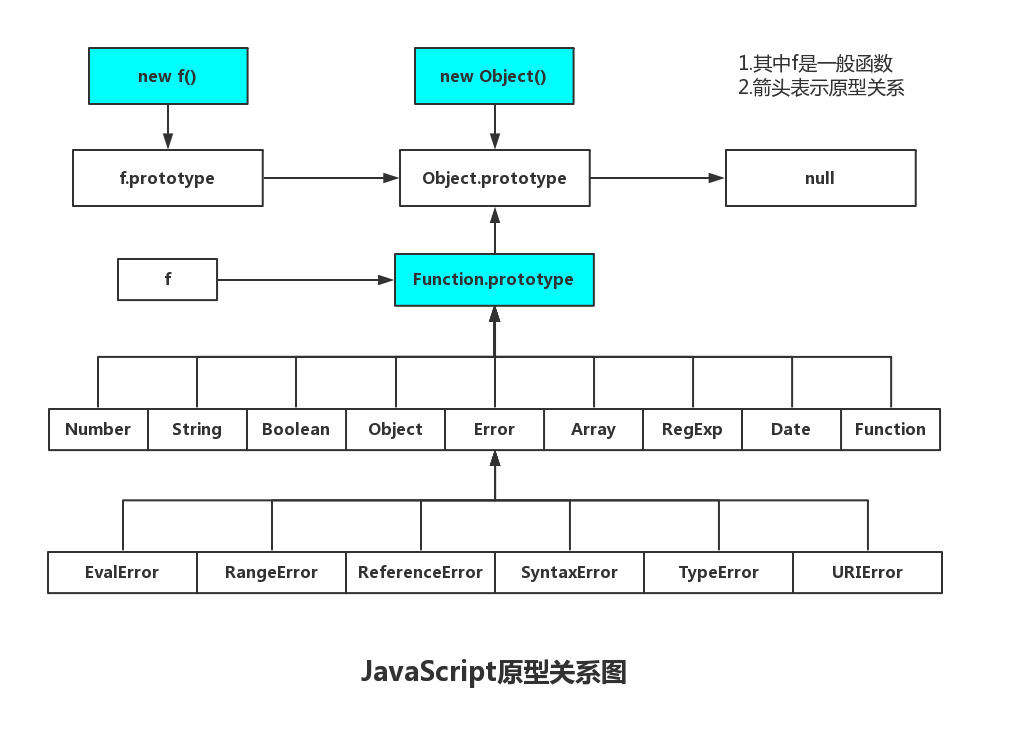1. 前言
大家好,我是若川。为了能帮助到更多对源码感兴趣、想学会看源码、提升自己前端技术能力的同学。我倾力最近组织了源码共读活动,已进行三个月,大家一起交流学习,共同进步,很多人都表示收获颇丰。
这是面试官问系列的第一篇,旨在帮助读者提升JS基础知识,包含new、call、apply、this、继承相关知识。<br>面试官问系列文章如下:感兴趣的读者可以点击阅读。<br>1.面试官问:能否模拟实现JS的new操作符<br>2.面试官问:能否模拟实现JS的bind方法<br>3.面试官问:能否模拟实现JS的call和apply方法<br>4.面试官问:JS的this指向<br>5.面试官问:JS的继承<br>
用过Vuejs的同学都知道,需要用new操作符来实例化。
new Vue({ el: '#app', mounted(){},});
复制代码
那么面试官可能会问是否想过new到底做了什么,怎么模拟实现呢。
附上之前写文章写过的一段话:已经有很多模拟实现new操作符的文章,为什么自己还要写一遍呢。学习就好比是座大山,人们沿着不同的路登山,分享着自己看到的风景。你不一定能看到别人看到的风景,体会到别人的心情。只有自己去登山,才能看到不一样的风景,体会才更加深刻。
2. new 做了什么
先看简单例子 1:
// 例子1function Student(){}var student = new Student();console.log(student); // {}// student 是一个对象。console.log(Object.prototype.toString.call(student)); // [object Object]// 我们知道平时声明对象也可以用new Object(); 只是看起来更复杂// 顺便提一下 `new Object`(不推荐)和Object()也是一样的效果// 可以猜测内部做了一次判断,用new调用/** if (!(this instanceof Object)) {* return new Object();* }*/var obj = new Object();console.log(obj) // {}console.log(Object.prototype.toString.call(student)); // [object Object]
typeof Student === 'function' // truetypeof Object === 'function' // true
复制代码
从这里例子中,我们可以看出:一个函数用new操作符来调用后,生成了一个全新的对象。而且Student和Object都是函数,只不过Student是我们自定义的,Object是JS本身就内置的。再来看下控制台输出图,感兴趣的读者可以在控制台试试。
与new Object() 生成的对象不同的是new Student()生成的对象中间还嵌套了一层__proto__,它的constructor是Student这个函数。
// 也就是说:student.constructor === Student;Student.prototype.constructor === Student;
复制代码
2.1 小结 1:从这个简单例子来看,new操作符做了两件事:
创建了一个全新的对象。
这个对象会被执行[[Prototype]](也就是__proto__)链接。
接下来我们再来看升级版的例子 2:
// 例子2function Student(name){ console.log('赋值前-this', this); // {} this.name = name; console.log('赋值后-this', this); // {name: '若川'}}var student = new Student('若川');console.log(student); // {name: '若川'}
复制代码
由此可以看出:这里Student函数中的this指向new Student()生成的对象student。
2.2 小结 2:从这个例子来看,new操作符又做了一件事:
生成的新对象会绑定到函数调用的this。
接下来继续看升级版例子 3:
// 例子3function Student(name){ this.name = name; // this.doSth();}Student.prototype.doSth = function() { console.log(this.name);};var student1 = new Student('若');var student2 = new Student('川');console.log(student1, student1.doSth()); // {name: '若'} '若'console.log(student2, student2.doSth()); // {name: '川'} '川'student1.__proto__ === Student.prototype; // truestudent2.__proto__ === Student.prototype; // true// __proto__ 是浏览器实现的查看原型方案。// 用ES5 则是:Object.getPrototypeOf(student1) === Student.prototype; // trueObject.getPrototypeOf(student2) === Student.prototype; // true
复制代码
关于 JS 的原型关系我之前看到这张图,觉得很不错,分享给大家。
2.3 小结 3:这个例子 3 再一次验证了小结 1 中的第 2 点。也就是这个对象会被执行[[Prototype]](也就是__proto__)链接。并且通过new Student()创建的每个对象将最终被[[Prototype]]链接到这个Student.protytype对象上。
细心的同学可能会发现这三个例子中的函数都没有返回值。那么有返回值会是怎样的情形呢。那么接下来请看例子 4
// 例子4function Student(name){ this.name = name; // Null(空) null // Undefined(未定义) undefined // Number(数字) 1 // String(字符串)'1' // Boolean(布尔) true // Symbol(符号)(第六版新增) symbol
// Object(对象) {} // Function(函数) function(){} // Array(数组) [] // Date(日期) new Date() // RegExp(正则表达式)/a/ // Error (错误) new Error() // return /a/;}var student = new Student('若川');console.log(student); {name: '若川'}
复制代码
我测试这七种类型后MDN JavaScript类型,得出的结果是:前面六种基本类型都会正常返回{name: '若川'},后面的Object(包含Functoin, Array, Date, RegExg, Error)都会直接返回这些值。
2.4 由此得出 小结 4:
如果函数没有返回对象类型Object(包含Functoin, Array, Date, RegExg, Error),那么new表达式中的函数调用会自动返回这个新的对象。
结合这些小结,整理在一起就是:
创建了一个全新的对象。
这个对象会被执行[[Prototype]](也就是__proto__)链接。
生成的新对象会绑定到函数调用的this。
通过new创建的每个对象将最终被[[Prototype]]链接到这个函数的prototype对象上。
如果函数没有返回对象类型Object(包含Functoin, Array, Date, RegExg, Error),那么new表达式中的函数调用会自动返回这个新的对象。
3. new 模拟实现
知道了这些现象,我们就可以模拟实现new操作符。直接贴出代码和注释
/** * 模拟实现 new 操作符 * @param {Function} ctor [构造函数] * @return {Object|Function|Regex|Date|Error} [返回结果] */function newOperator(ctor){ if(typeof ctor !== 'function'){ throw 'newOperator function the first param must be a function'; } // ES6 new.target 是指向构造函数 newOperator.target = ctor; // 1.创建一个全新的对象, // 2.并且执行[[Prototype]]链接 // 4.通过`new`创建的每个对象将最终被`[[Prototype]]`链接到这个函数的`prototype`对象上。 var newObj = Object.create(ctor.prototype); // ES5 arguments转成数组 当然也可以用ES6 [...arguments], Aarry.from(arguments); // 除去ctor构造函数的其余参数 var argsArr = [].slice.call(arguments, 1); // 3.生成的新对象会绑定到函数调用的`this`。 // 获取到ctor函数返回结果 var ctorReturnResult = ctor.apply(newObj, argsArr); // 小结4 中这些类型中合并起来只有Object和Function两种类型 typeof null 也是'object'所以要不等于null,排除null var isObject = typeof ctorReturnResult === 'object' && ctorReturnResult !== null; var isFunction = typeof ctorReturnResult === 'function'; if(isObject || isFunction){ return ctorReturnResult; } // 5.如果函数没有返回对象类型`Object`(包含`Functoin`, `Array`, `Date`, `RegExg`, `Error`),那么`new`表达式中的函数调用会自动返回这个新的对象。 return newObj;}
复制代码
最后用模拟实现的newOperator函数验证下之前的例子 3:
// 例子3 多加一个参数function Student(name, age){ this.name = name; this.age = age; // this.doSth(); // return Error();}Student.prototype.doSth = function() { console.log(this.name);};var student1 = newOperator(Student, '若', 18);var student2 = newOperator(Student, '川', 18);// var student1 = new Student('若');// var student2 = new Student('川');console.log(student1, student1.doSth()); // {name: '若'} '若'console.log(student2, student2.doSth()); // {name: '川'} '川'
student1.__proto__ === Student.prototype; // truestudent2.__proto__ === Student.prototype; // true// __proto__ 是浏览器实现的查看原型方案。// 用ES5 则是:Object.getPrototypeOf(student1) === Student.prototype; // trueObject.getPrototypeOf(student2) === Student.prototype; // true
复制代码
可以看出,很符合new操作符。读者发现有不妥或可改善之处,欢迎指出。回顾这个模拟new函数newOperator实现,最大的功臣当属于Object.create()这个ES5提供的API。
4. Object.create() 用法举例
我之前整理的一篇文章中也有讲过,可以翻看JavaScript 对象所有API解析
MDN Object.create()
Object.create(proto, [propertiesObject])方法创建一个新对象,使用现有的对象来提供新创建的对象的__proto__。它接收两个参数,不过第二个可选参数是属性描述符(不常用,默认是undefined)。
var anotherObject = { name: '若川'};var myObject = Object.create(anotherObject, { age: { value:18, },});// 获得它的原型Object.getPrototypeOf(anotherObject) === Object.prototype; // true 说明anotherObject的原型是Object.prototypeObject.getPrototypeOf(myObject); // {name: "若川"} // 说明myObject的原型是{name: "若川"}myObject.hasOwnProperty('name'); // false; 说明name是原型上的。myObject.hasOwnProperty('age'); // true 说明age是自身的myObject.name; // '若川'myObject.age; // 18;
复制代码
对于不支持ES5的浏览器,MDN上提供了ployfill方案。
if (typeof Object.create !== "function") { Object.create = function (proto, propertiesObject) { if (typeof proto !== 'object' && typeof proto !== 'function') { throw new TypeError('Object prototype may only be an Object: ' + proto); } else if (proto === null) { throw new Error("This browser's implementation of Object.create is a shim and doesn't support 'null' as the first argument."); }
if (typeof propertiesObject != 'undefined') throw new Error("This browser's implementation of Object.create is a shim and doesn't support a second argument.");
function F() {} F.prototype = proto; return new F(); };}
复制代码
到此,文章就基本写完了。感谢读者看到这里。
5. 最后总结一下:
new做了什么:
创建了一个全新的对象。
这个对象会被执行[[Prototype]](也就是__proto__)链接。
生成的新对象会绑定到函数调用的this。
通过new创建的每个对象将最终被[[Prototype]]链接到这个函数的prototype对象上。
如果函数没有返回对象类型Object(包含Functoin, Array, Date, RegExg, Error),那么new表达式中的函数调用会自动返回这个新的对象。
怎么模拟实现
// 去除了注释function newOperator(ctor){ if(typeof ctor !== 'function'){ throw 'newOperator function the first param must be a function'; } newOperator.target = ctor; var newObj = Object.create(ctor.prototype); var argsArr = [].slice.call(arguments, 1); var ctorReturnResult = ctor.apply(newObj, argsArr); var isObject = typeof ctorReturnResult === 'object' && ctorReturnResult !== null; var isFunction = typeof ctorReturnResult === 'function'; if(isObject || isFunction){ return ctorReturnResult; } return newObj;}
复制代码
读者发现有不妥或可改善之处,欢迎指出。另外觉得写得不错,可以点个赞,也是对我的一种支持。
最后可以持续关注我 @若川。欢迎与我交流,参与 源码共读 活动,每周大家一起学习 200 行左右的源码,共同进步。














评论